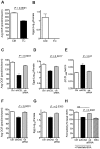Fatty acid oxidation is essential for egg production by the parasitic flatworm Schistosoma mansoni
- PMID: 23133378
- PMCID: PMC3486914
- DOI: 10.1371/journal.ppat.1002996
Fatty acid oxidation is essential for egg production by the parasitic flatworm Schistosoma mansoni
Abstract
Schistosomes, parasitic flatworms that cause the neglected tropical disease schistosomiasis, have been considered to have an entirely carbohydrate based metabolism, with glycolysis playing a dominant role in the adult parasites. However, we have discovered a close link between mitochondrial oxygen consumption by female schistosomes and their ability to produce eggs. We show that oxygen consumption rates (OCR) and egg production are significantly diminished by pharmacologic inhibition of carnitine palmitoyl transferase 1 (CPT1), which catalyzes a rate limiting step in fatty acid β-oxidation (FAO) and by genetic loss of function of acyl CoA synthetase, which complexes with CPT1 and activates long chain FA for use in FAO, and of acyl CoA dehydrogenase, which catalyzes the first step in FAO within mitochondria. Declines in OCR and egg production correlate with changes in a network of lipid droplets within cells in a specialized reproductive organ, the vitellarium. Our data point to the importance of regulated lipid stores and FAO for the compartmentalized process of egg production in schistosomes.
Conflict of interest statement
The authors have declared that no competing interests exist.
Figures




Similar articles
-
Schistosoma mansoni does not and cannot oxidise fatty acids, but these are used for biosynthetic purposes instead.Int J Parasitol. 2019 Jul;49(8):647-656. doi: 10.1016/j.ijpara.2019.03.005. Epub 2019 Jun 3. Int J Parasitol. 2019. PMID: 31170410
-
Aspects of long-chain acyl-COA metabolism.Mol Cell Biochem. 1975 Apr 30;7(1):19-31. doi: 10.1007/BF01732160. Mol Cell Biochem. 1975. PMID: 1134497
-
Participation of peroxisomes in the metabolism of xenobiotic acyl compounds: comparison between peroxisomal and mitochondrial beta-oxidation of omega-phenyl fatty acids in rat liver.Biochim Biophys Acta. 1987 Sep 25;921(2):292-301. Biochim Biophys Acta. 1987. PMID: 3651489
-
Turning down lipid oxidation during heavy exercise--what is the mechanism?J Physiol Pharmacol. 2008 Dec;59 Suppl 7:19-30. J Physiol Pharmacol. 2008. PMID: 19258655 Review.
-
Fatty acid import into mitochondria.Biochim Biophys Acta. 2000 Jun 26;1486(1):1-17. doi: 10.1016/s1388-1981(00)00044-5. Biochim Biophys Acta. 2000. PMID: 10856709 Review.
Cited by
-
Increased hepatic interleukin-1, arachidonic acid, and reactive oxygen species mediate the protective potential of peptides shared by gut cysteine peptidases against Schistosoma mansoni infection in mice.PLoS Negl Trop Dis. 2023 Mar 15;17(3):e0011164. doi: 10.1371/journal.pntd.0011164. eCollection 2023 Mar. PLoS Negl Trop Dis. 2023. PMID: 36920999 Free PMC article.
-
A worm of one's own: how helminths modulate host adipose tissue function and metabolism.Trends Parasitol. 2015 Sep;31(9):435-41. doi: 10.1016/j.pt.2015.04.008. Epub 2015 May 16. Trends Parasitol. 2015. PMID: 25991556 Free PMC article. Review.
-
Human schistosomiasis.Lancet. 2014 Jun 28;383(9936):2253-64. doi: 10.1016/S0140-6736(13)61949-2. Epub 2014 Apr 1. Lancet. 2014. PMID: 24698483 Free PMC article. Review.
-
A Novel Methodology for Bioenergetic Analysis of Plasmodium falciparum Reveals a Glucose-Regulated Metabolic Shift and Enables Mode of Action Analyses of Mitochondrial Inhibitors.ACS Infect Dis. 2016 Dec 9;2(12):903-916. doi: 10.1021/acsinfecdis.6b00101. Epub 2016 Oct 25. ACS Infect Dis. 2016. PMID: 27718558 Free PMC article.
-
Epigenetic changes modulate schistosome egg formation and are a novel target for reducing transmission of schistosomiasis.PLoS Pathog. 2014 May 8;10(5):e1004116. doi: 10.1371/journal.ppat.1004116. eCollection 2014 May. PLoS Pathog. 2014. PMID: 24809504 Free PMC article.
References
-
- Chitsulo L, Loverde P, Engels D (2004) Schistosomiasis. Nat Rev Microbiol 2: 12–13. - PubMed
-
- King CH, Dangerfield-Cha M (2008) The unacknowledged impact of chronic schistosomiasis. Chronic Illn 4: 65–79. - PubMed
-
- Pearce EJ, MacDonald AS (2002) The immunobiology of schistosomiasis. Nat Rev Immunol 2: 499–511. - PubMed
-
- LoVerde PT (2002) Presidential address. Sex and schistosomes: an interesting biological interplay with control implications. J Parasitol 88: 3–13. - PubMed
-
- Basch PF, Basch N (1984) Intergeneric reproductive stimulation and parthenogenesis in Schistosoma mansoni. Parasitology 89 Pt 2: 369–376. - PubMed
Publication types
MeSH terms
Substances
Grants and funding
LinkOut - more resources
Full Text Sources
Other Literature Sources

